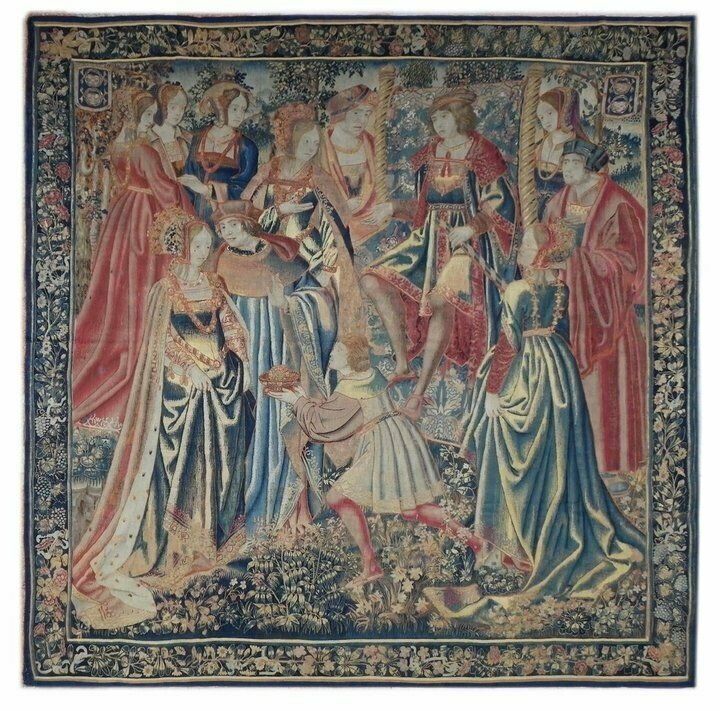BRUSSELS TAPESTRY - Purchase Sale Cleaning Restoration Expertise
Tapestry of Brussels
The tapestry of Brussels is the name given to the production of the many high-smooth tapestry workshops active in Brussels from the beginning of the fifteenth century until the end of the eighteenth century.
For a long time, the upholsterers of Arras or Tournai were the most productive. Tournai was a city of French political obedience until 1521. The first mentions of upholsterers in Tournai date back to 1295. The tapestry workshops of Tournai produced important historiated hangings illustrating the same subject of biblical, historical, mythological or romantic inspiration, taking up the chivalrous ideals of the court of Burgundy. In 1448 Philippe le Bon commissioned the hanging of the History of Gédéon (see the photo of the Brussels tapestry in our collection, History of Gédéon) or the Golden Fleece to be delivered in four years, and which was, according to Eugène Soil, "the most famous piece to come out of the workshops in Tournai".1 Around 1530, Tournai, which had taken over the first place in Arras in the production of tapestries, saw new competitors develop, Brussels, Lille, etc. The production of tapestries will stop in Tournai in 1720.
Six tapestries from the Story of Gideon series are exhibited in two adjacent rooms of the Diocesan Museum of Albarracín, itself located in the former Episcopal Palace next to the Cathedral.
This is probably the last of the seven existing tapestries, and may be the last of the series as a whole, since it represents the last episode in the Story of Gideon. The panel depicts the Israelites handing over to Gideon the booty they had obtained from their conquered enemies. The arrangement of the characters in a fertile setting.
The importance of the upholsterers of Arras can be seen in the name "arazzo" or "arrazzy" used in Italy or Poland, "drap de Ras" in Spain to designate the tapestries, long after Arras had lost its predominance. The decadence of Arras began when, in 1398, the Duke of Burgundy, Philip the Good, decided, in order to redress the city's finances, to double the tax on the high hills. Merchants and tapestry workers then began to leave the city to settle in Tournai, Lille, Oudenaarde, then Brussels and Bruges2. As early as 1449, Duke Philip the Good preferred to order the hanging of the story of Gideon in Tournai rather than in Arras. In 1456, the bourgeois of Arras complained to the Duke of Burgundy that the workers in Haute-Lisse were leaving Arras to settle in Valenciennes, Tournai, Bergues and other towns. Arras then lost the duke's orders. Charles the Bold's demands for money to finance the war began to ruin the city3. The conquest of Arras by Louis XI led to the relocation of the tapestry workshops to the Habsburg Netherlands in 1477, and the control of Brussels by the House of Habsburg and the difficulties of Arras allowed the development of production in Brussels.
Very beautiful and exceptional tapestry from Flanders, Brussels executed in wool and silk around 1680 - 1700. The composition of the cardboard suggests that it most probably comes from a work by Lodewijk Van Schoor.
At the beginning of the 16th century, the rise to the main thrones of Europe of sovereigns enamoured of grandeur, and in the Netherlands of regents passionate about tapestry, was to be the source of rivalry between the various Royal and Princely Courts to possess the most beautiful tapestries, which was favourable to the Brussels workshops which employed up to 15,000 people in the 16th century.
A regulation of 1476 stipulated that only painters were allowed to design the models for the tapestries, unless they were greens.
Mark of the Brussels Tapestry
In order to combat counterfeiting, the marks of the city of Brussels and of the tapestry workshops were made compulsory on tapestries by an order of the Brussels magistrate issued on 16 May 1528 for each tapestry of more than 6 aunes. This obligation was repeated in the imperial edict of 16 May 1544 concerning the organisation of the tapestry industry. The mark of Brussels is made of a small red shield flanked on both sides by capital letters B for Brabant Brussels. The monogram of the lissier had to be deposited in a register of the corporation. This document was destroyed in a fire in 1690.
This Tapestry represents the error of Oeneas who failed to offer a sacrifice to Artemis. He can be seen kneeling before Dionysus offering him a bunch of grapes. He thus turns his back on Artemis who descends from the Pantheon and has no idea of the fate that will befall him.





